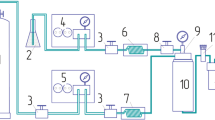Abstract
To verify the effect of hydrogen bonding on the polymer mixing, blends of poly(vinyl methyl ether) (PVME) and poly(methyl methacrylate) (PMMA) with poly(4-hydroxy styrene) (PHS), respectively, have been prepared. The effect of hydrogen bond strength on the enthalpy of mixing, ΔH M, was investigated by microcalorimetric measurements and FTIR spectroscopy. Infrared analysis allowed to measure the amount of hydrogen bonding by a curve fitting procedure in PHS/PMMA blends, looking to the change in the characteristic bands of carbonyl group of PMMA. In the case of PHS/PMVE, the hydroxyl-stretching region has been investigated to have only a qualitative estimation of hydrogen bonding. For both PHS/PMVE and PHS/PMMA systems, the measured exothermic (negative) ΔH M decreases with the increase in the PHS content, indicating that the presence of strong specific intermolecular interactions, such as hydrogen bonding, favours the polymer blending.

Similar content being viewed by others
References
Painter PC, Graf JF, Coleman MM (1991) Effect of hydrogen bonding on the enthalpy of mixing and the composition dependence of the glass transition temperature in polymer blends. Macromolecules 24:5630–5638
Moskala EJ, Varnell DF, Coleman MM (1985) Concerning the miscibility of poly(vinylphenol) blends FTIR study. Polymer 26:228–234
Lezcano EG, de Ramirez Arellano D, Prolongo MG, Coll CS (1998) Miscibility and interactions in poly (vinyl methylether)/poly(4-hydroxystyrene) blends. Polymer 39:1583–1589
Gestoso P, Brisson J (2001) Orientation of uniaxially stretched poly(vinyl phenol)/poly(vinyl methyl ether) blends. Polymer 42:8415–8424
Gestoso P, Brisson J (2003) Towards the simulation of poly(vinyl phenol)/poly(vinyl methyl ether) blends by atomistic molecular modelling. Polymer 44:2321–2329
Zhang SH, Jin X, Painter PC, Runt J (2004) Composition-dependent dynamics in miscible polymer blends: influence of intermolecular hydrogen bonding. Polymer 45:3933–3942
Coleman MM, Lichkus AM, Painter PC (1989) Thermodynamics of hydrogen bonding in polymer blends. 3. Experimental studies of blends involving poly(4-vinylphenol). Macromolecules 22:586–595
Gestoso P, Brisson J (2003) Investigation of the effect of chain rigidity on orientation of polymer blends: the case of poly(vinyl phenol)/poly(ethylene terephthalate) blends. Polymer 44:7765–7776
Li D, Brisson J (1998) Hydrogen bonds in poly(methyl methacrylate)-poly(4-vinyl phenol) blends 1. Quantitative analysis using FTi.r. spectroscopy. Polymer 39:793–800
Li D, Brisson J (1998) Hydrogen bonds in poly(methyl methacrylate)-poly(4-vinyl phenol) blends 2. Quantification near the glass transition temperature. Polymer 39:801–810
Serman CJ, Painter PC, Coleman MM (1991) Studies of the phase behaviour of poly(vinyl phenol)-poly(n-alkyl methacrylate) blends. Polymer 32:1049–1058
Pomposo JA, Eguiazabal I, Calahorra C, Cortàzar M (1993) Glass transition behaviour and interactions in poly (p-vinyl phenol)/polymethacrylate blends. Polymer 34:95–102
Hsu WP (1997) Influence of tacticity of poly(methyl methacrylate) on the compatibility with poly(vinyl phenol). J Appl Polym Sci 66:1773–1780
Serman CJ, Xu Y, Painter PC, Coleman MM (1989) On the phase behavior and the limits of miscibility of styrene-co-vinylphenol blends with poly(alky1 methacrylates). Macromolecules 22:2015–2019
Cowie JMG, Ferguson R (1989) Physical aging studies in polymer blends. 2. Enthalpy relaxation as a function of aging temperature in a poly(viny1methyl ether)/polystyrene blend. Macromolecules 22:2312–2317
Li D, Brisson J (1996) DMTA and FTIR investigation of the phase behavior of poly(methyl methacrylate)–poly(4-vinylphenol) blends. Macromolecules 29:868–874
Li D, Brisson J (1997) Orientation behavior in uniaxially stretched poly(methyl methacrylate)–poly(4-vinylphenol) blends. Macromolecules 30:8425–8432
Hsu WP (2002) Reexamination of the miscibility of stereoregular poly(methyl methacrylate) with poly(vinyl phenol). J Appl Polym Sci 83:1425–1431
Hsu WP, Yeh CF (1999) Polymer blends of stereoregular poly(methyl methacrylate) and poly(styrene-co-p-hydroxystyrene). J Appl Polym Sci 73:431–440
Coleman MM, Graf JF, Painter PC (1991) Specific interactions and the miscibility of polymer blends. Technomic Publishing Co. Inc. Lancaster
Brandrup J, Immergut EH (eds) (1989) Polymer Handbook, 3rd edn. Wiley-Interscience, New York
Cowie JMG, Arrighi V, McGonigle E-A (2005) Enthalpy relaxation in poly(4-hydroxystyrene)/poly(methyl methacrylate) blends. Macromol Chem Phys 206:767–776
Garton A (1992) Infrared spectroscopy of polymer blends, composites and surfaces. Hanser Publishers, Munich
Arrighi V, Cowie JMG, Ferguson R, McEwen IJ, McGonigle E-A, Pethrick RA, Princi E (2005) Physical ageing in poly(4-hydroxy styrene)/poly(vinyl methyl ether) blends. Polym Int 55:749–756
Serman CJ, Xu Y, Painter PC, Coleman MM (1991) Poly(vinyl phenol)—polyether blends. Polymer 32:516–522
Casarino P, Vicini S, Pedemonte E (2001) Thermodynamics of polymer mixtures: study on the mixing process of the poly(styrene)/poly(vinyl methyl ether) system. Thermochim Acta 372:59–66
Princi E, Vicini S, Pedemonte E (2009) Effect of ester group bulkiness of polyacrylates on miscibility with poly(vinyl acetate). Polym Int 58:656–664
Vicini S, Princi E, Pedemonte E (2008) Thermodynamic of polymer mixtures: the LCT applied to the poly(styrene)/poly(vinyl methylether) system. J Polym Sci Part B Polym Phys 46:791–797
Princi E, Vicini S (2010) Evaluation of the interaction parameter for poly(ɛ-caprolactone)/poly(styrene-co-acrylonitrile) blends. J Polym Sci Part B Polym Phys 48:2129–2139
Petrie SEB, Marshall AS (1975) Rate-determining factors for enthalpy relaxation of glassy polymers. Molecular weight. J Appl Phys 46:4223–4230
Acknowledgments
The authors would like to thank Prof. Enrico Pedemonte and Prof. Valeria Arrighi for the support, the suggestions and the fruitful discussions.
Author information
Authors and Affiliations
Corresponding author
Rights and permissions
About this article
Cite this article
Vicini, S., Castellano, M. & Princi, E. Evaluation of enthalpy of mixing by calorimetric method: effect of hydrogen bonding in poly(4-hydroxy styrene)-based blends. Polym. Bull. 72, 743–753 (2015). https://doi.org/10.1007/s00289-015-1302-y
Received:
Revised:
Accepted:
Published:
Issue Date:
DOI: https://doi.org/10.1007/s00289-015-1302-y




